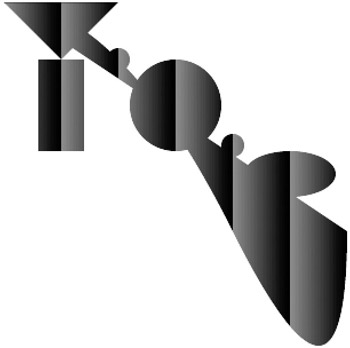Gradient Checkerboards and Multi-Quadratic Bezier Clip Paths
|
|
|
Venetian Checkerboards and Quadratic Bezier Clip Paths
Consider the gradient checkerboard pattern rendered in Figure 5.3.

Figure 5.3: A Venetian quadratic Bezier-bound gradient checkerboard pattern.
The SVG document in Listing 5.3 demonstrates how to use the SVG path element in order to generate a Venetian gradient checkerboard pattern bound by a quadratic Bezier curve.
Listing 5.3 vVenetianGradientPatternQBCP1.svg
<?xml version="1.0" encoding="iso-8859-1"?> <!DOCTYPE svg PUBLIC "-//W3C//DTD SVG 20001102//EN" "http://www.w3.org/TR/2000/CR-SVG-20001102/DTD/svg-20001102.dtd"> <svg width="100%" height="100%"> <defs> <pattern width="50" height="50" patternUnits="userSpaceOnUse"> <linearGradient x1="0" y1="0" x2="50" y2="0" gradientUnits="userSpaceOnUse" spreadMethod="repeat"> <stop offset="0%" style="stop-color:#FF0000"/> <stop offset="100%" style="stop-color:#000000"/> </linearGradient> <rect style="fill:url(#repeatedGradientDefinition)" x="0" y="0" width="50" height="50"/> </pattern> <clipPath clipPathUnits="userSpaceOnUse"> <path d="m0,0 Q100,0 200,200 T300,200" style="fill:red;stroke:blue;stroke-width:4;"/> <path d="m0,0 l50,50 l50,-50"/> <rect x="30" y="50" width="40" height="80"/> <circle cx="100" cy="50" r="10"/> <circle cx="150" cy="90" r="40"/> <circle cx="200" cy="125" r="10"/> <ellipse cx="250" cy="150" rx="40" ry="20"/> </clipPath> </defs> <g transform="translate(50,50)" clip-path="url(#clipPathDefinition)" stroke="black" fill="none"> <rect style="fill:url(#multiPattern)" x="0" y="0" width="400" height="400"/> </g> </svg>
Remarks
The SVG code in Listing 5.3 contains the same quadratic Bezier curve as Listing 5.1, and it uses this Bezier curve as a clip path while rendering a gradient checkerboard pattern consisting of rectangles. These rectangles are rendered with vertical linear gradient shading that varies linearly from red to black in order to create a 'Venetian shading' effect. Now look at the SVG defs element, which starts with the definition of a checkerboard pattern whose id attribute has the value checkerPattern, followed by an SVG clipPath element whose id attribute equals clipPathDefinition.
The actual rendering takes place in the SVG g element, which first translates the origin from the point (0,0) to the point (50,50). Notice how the SVG g element also contains the following line that specifies the clip path that is defined in the SVG defs element:
clip-path="url(#clipPathDefinition)" stroke="black" fill="none">
Now that the 'core' definition and code is in place, you can add various SVG elements as you see fit; in this example, we have an SVG rect element, three SVG circle elements, and one SVG ellipse element, all of which have the same fill attribute applied to them.
|
|
|
EAN: 2147483647
Pages: 362